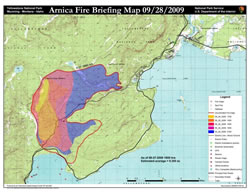
National Fire Plan Success Story
Arnica Fire: Cost Efficient and Resource Sensitive
Yellowstone National Park, Wyoming
National Fire Plan - Fuels Reduction
2009

Briefing map for the Arnica Fire. Larger version of the map (97 kb).
Fire managers can manage fires on federally protected lands with the full range of management options, depending on the latitude provided in the administrative unit’s fire management plan. This fall, Yellowstone National Park managers had a variety of options open to them with the Arnica Fire, which grew to about 11,000 acres and approached a major park development.
Fire managers adopted a point protection strategy, basically allowing the fire to come to them. The strategic goal was to use the fire to create a fire break between the historic Lake Yellowstone Village and future fires on the central plateau that could ride prevailing winds toward this location.
No retardant or chemical foam was used. Fire managers drew lake water by helicopter, using bucket drops to cool the near side of the fire. They made water drops in the same drainage from which the water came to control invasive aquatic species, and limited landings near the fire to respect wilderness values.
Firefighters did not construct traditional fireline; instead, they laid six-inch irrigation pipe with spray heads in an arc from Lake Yellowstone around the development and soaked the area for two days with lake water from a 3000 gallon per minute, 150 psi pump. They took point protection measures using port-a-tanks, pumps, and sprinklers. Eighteen wildland and structural engines participated, and crews made light fuels reduction treatments in the vicinity of structures. One hotshot crew and a squad of smokejumpers filled in vital roles, a total of approximately 165 people were involved.
The park managed the fire as a Type III incident with a curtailed management and logistics support relative to the fire’s size. Cooperators from the Gallatin National Forest, park concessioner Xanterra Parks and Recreation, and Yellowstone Maintenance, Interpretation, Ranger and Administrative personnel provided vital support functions. While this set of strategies and tactics is not applicable to every wildland fire management scenario, the Arnica Fire was managed efficiently with regards to cost and environmental sensitivity.
Contact: Andy Mitchell, Assistant Fire Management Officer, (307) 344-2182.